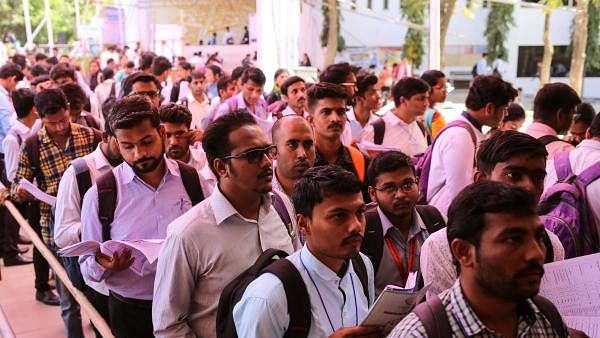
Job seekers line up for walk-in interview. Representative image.
PTI
If we look at India’s gross domestic product growth numbers, the economy is indeed progressing. Few countries can match its growth rate, reportedly around 7%. However, not all economists are ready to celebrate. There are serious concerns, the most pressing being the lack of job opportunities for educated young people. Economists and social scientists often describe this as jobless growth. Joblessness has become a significant political issue as well. In its 2014 election manifesto, the Bharatiya Janata Party promised to create two crore jobs annually, which has remained unfulfilled.
The government’s approach to this crisis raises doubts about its commitment to creating new jobs. Prime Minister Modi, in his speeches, often emphasises numbers—the number of schemes launched and people covered—but results remain elusive.
The recently announced PM Internship Scheme is also about numbers. Proposed in the 2024 Union Budget, the scheme aims to offer 12-month internships to 10 million young people in the top 500 companies over five years. The Ministry of Corporate Affairs is to administer the scheme in partnership with industry bodies such as the Confederation of Indian Industry and Federation of Indian Chambers of Commerce and Industry. As of now, 125,000 internships across 24 sectors are available from 200 companies. Registrations for the first phase, which closed on October 25, received a good response, which may prompt the government to term the scheme a success.
Internships are standard in many professional courses, where students must complete a set period (typically two to six months) to gain practical experience in their field. Institutes often help students secure internships, or students find the opportunities on their own.
Under the PM Internship Scheme, which differs from these course-based internships, selected candidates will receive a monthly stipend of Rs 5,000—90% of which will be funded by the government, with the rest contributed by the employer. Additionally, candidates will get a one-time grant of Rs 6,000. According to the official website, the scheme’s goal is to expose young people to real-world business environments, helping them gain work experience that could improve their career prospects.
After completing this internship, candidates may highlight it on their resumes, hoping it will give them an advantage over peers without such experience. However, whether this advantage materialises remains uncertain.
The stipend is too low—insufficient even to cover rent in most locations. Whether the stipend is comparable to minimum wage levels remains a question. The Centre for Development of Advance Computing (C-DAC), a government organisation, recently offered an internship stipend of Rs 50,000 per month. While it may be unrealistic to expect the government to spend this amount on 10 million interns, Rs 5,000 appears paltry. The Mukhyamantri Yuva Karya Prakshikshan Yojana in Maharashtra, a similar scheme, offers a Rs 10,000 monthly stipend for graduate interns.
When managed well and completed diligently, an internship can be a valuable learning experience. Before the PM Internship Scheme, companies often offered permanent roles to interns based on their performance and potential, though such cases were rare. Under the new scheme, only a few hundred might be absorbed by the companies they intern with, assuming suitable roles are available. This is feasible primarily in the private sector, as the government departments and public sector enterprises lack provisions for hiring interns. In today’s cost-cutting environment, no company is likely to create vacancies solely to absorb interns.
Interns aren’t always welcomed, and internship experiences can vary widely. Some interns lack proper workspace or receive insuffient guidance. Others face exploitation, with excessive workloads or menial tasks beyond the internship’s scope. These realities serve as a reminder that internships are not always pleasant ones and can be challenging.
To support the internship scheme, the government has revised corporate social responsibility guidelines, allowing central public sector enterprises to allocate up to 60% of their CSR budgets to this initiative. Private companies will contribute Rs 500 per intern from their CSR budgets, minimising the financial burden on these enterprises.
Many Indians are willing to accept riskier jobs in countries like Israel and Russia. The truth is, the government lacks clarity on how to deal with the unemployment situation. The PM Internship Scheme may help a few, but it doesn’t provide any concrete solution, though the government may take pride in the scheme as it has found the easiest way to show the numbers.
(The writer is a former banker)